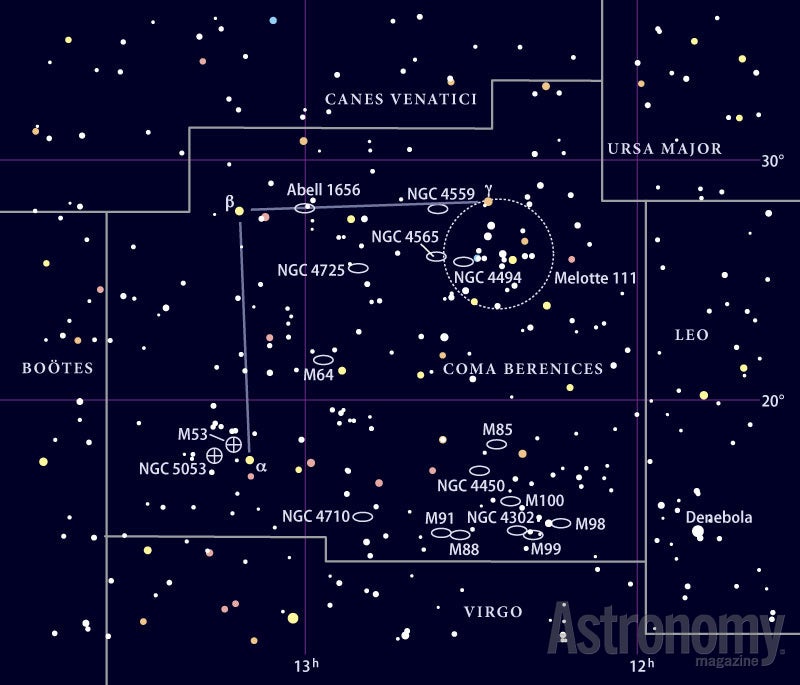Targets for July 7–14, 2016
Largetelescope: The Silver Streak Galaxy (NGC 4216)
Large telescope: Spiral galaxy M100
Large telescope: Barred spiral galaxy M91
A streak of light in Virgo
This week’s first star city is the Silver Streak Galaxy, a spiral in the constellation Virgo the Maiden. Observers also know it as the Weaver’s Shuttle Galaxy and NGC 4216.
To find it, start at the hindquarters of Leo the Lion. From Chertan (Theta [θ] Leonis), draw a line through Denebola (Beta [β] Leonis), and extend it nearly as far eastward as the distance between those two stars. Your destination is the western edge of the Coma-Virgo cluster of galaxies. From a dark site, a 10-inch telescope will reveal several hundred galaxies here, so use a high-quality star chart, and be sure of your identifications.
NGC 4216 itself appears as a magnitude 10.0 streak of light four times as long as it is wide. It measures 7.8′ by 1.6′. The core appears bright, but to see its bulge requires a 14-inch or larger scope. Also look for magnitude 12.2 NGC 4206, which lies 12′ to the southwest of NGC 4216. It has a similar appearance to its brighter neighbor.
The name “Weaver’s Shuttle” comes to this galaxy from the astronomy popularizer George F. Chambers, who revised Admiral William Smyth’s Cycle of Celestial Objects in 1881. Chambers described NGC 4216 this way: “This is a very curious object, in shape resembling a weaver’s shuttle, and lying across the parallel; the upper branch is the faintest, and the centre exhibits a palpable nucleus, which in my instrument brightens at intervals, as the eye rallies.”
A nice round number
This week’s second galaxy is M100 — a spiral on French comet-hunter Charles Messier’s list. It shines at magnitude 9.4, measures 6.2′ by 5.3′, and lies in the constellation Coma Berenices.
In the Northern Hemisphere’s spring, the Milky Way encircles us along the horizon, turning the rest of the sky into a large, clear window for viewing distant star cities. The north galactic pole, that point in the sky farthest from the plane of our galaxy, resides in Coma Berenices. Despite being a mid-sized constellation, it contains no fewer than eight Messier objects — including M100 — and dozens of bright, nearby galaxies of the Coma-Virgo galaxy cluster.
Messier’s contemporary, French astronomer Pierre Méchain, discovered M100 on March 15, 1781. It ranks as one of the brightest galaxies in the Coma-Virgo cluster, and it is a great target for amateur telescopes. It lies 8.3° east of magnitude 2.1 Denebola (Beta Leonis), or 1.9° east-northeast of the magnitude 5.1 star 6 Comae Berenices.
Through an 8-inch scope at low to medium power, look for a haze about 4′ long. You won’t see this galaxy’s spiral arms until you crank the magnification past 200x, and then only on the best nights.
The arms appear as brighter regions just to the east and west of the nucleus. Through a 12-inch telescope, you’ll trace the spiral structure twice as far from the core. Two faint dwarf galaxies lie to the north and east. Magnitude 13.9 NGC 4322, to the north, appears to be M100’s true companion, while magnitude 14.3 NGC 4328 lies in the foreground to the east.
Another M in Coma
This week’s final galaxy is M91 — a barred spiral on Messier’s list that you’ll also find in Coma Berenices.
The easiest way to locate it is to start at bright M88 and move 0.8° east. Or, point your scope 7.4° west-northwest of Vindemiatrix (Epsilon [ε] Virginis). M91 glows at magnitude 10.2 and measures 5.0′ by 4.1′.
Through a 6-inch telescope, you’ll see a nearly rectangular object a bit longer than it is wide. Its central region is broad and bright. Through a 12-inch scope at 200x, you’ll easily see the bar. Look even more closely, and you might spot one of the spiral arms. The brighter one extends southward from the east end of the bar.
Expand your observing at Astronomy.com
The Sky this Week
Get a daily digest of celestial events coming soon to a sky near you.
Observing Basics
Find more guidance from Senior Editor Michael E. Bakich with his Observing Basics video series.










